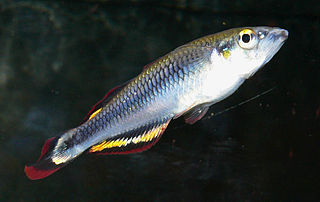
Bedotia is a genus of the family Bedotiidae of fishes endemic to Madagascar.

Helichrysum aciculare is a species of flowering plant in the family Asteraceae. It is found only in Yemen. Its natural habitat is rocky areas.
Helichrysum arachnoides is a species of flowering plant in the family Asteraceae. It is found only in Yemen. Its natural habitat is subtropical or tropical dry forests.
Helichrysum balfourii is a species of flowering plant in the family Asteraceae. It is found only in Yemen. Its natural habitat is subtropical or tropical dry forests.

Helichrysum nimmoanum is a species of flowering plant in the family Asteraceae. It is found only on the island of Socotra in Yemen. Its natural habitat is subtropical or tropical dry forests.
Helichrysum paulayanum is a species of flowering plant in the family Asteraceae. It is found only in Yemen.
Helichrysum sp. nov. C is a species of flowering plant in the family Asteraceae. It is found only in Yemen. Its natural habitat is rocky areas. It is threatened by habitat loss.
Helichrysum sp. nov. D is a species of flowering plant in the family Asteraceae. It is found only in Yemen. Its natural habitat is rocky areas.
Helichrysum sp. nov. E is a species of flowering plant in the family Asteraceae. It is found only in Yemen. Its natural habitat is rocky areas.
Helichrysum sphaerocephalum is a species of flowering plant in the family Asteraceae. It is found only in Yemen. Its natural habitats are subtropical or tropical dry forests, subtropical or tropical dry shrubland, and rocky areas.

Helichrysum suffruticosum is a species of flowering plant in the family Asteraceae. It is found only in Yemen. Its natural habitat is subtropical or tropical dry forests.

Hypericum scopulorum is a species of flowering plant in the family Hypericaceae. It is endemic to Socotra, an island archipelago that is part of Yemen. It is a common plant in shrubland habitat, and it is a dominant species in some areas along with Cephalocroton and another local endemic, Helichrysum rosulatum.
Aplocheilichthys sp. nov. 'Naivasha' was a formally undescribed species of freshwater fish in the family Poeciliidae. It was endemic to Kenya, but went extinct.
Haplochromis sp. nov. 'Amboseli' is a species of fish in the family Cichlidae. It is endemic to Kenya. Its natural habitat is swamps. It is threatened by habitat loss.
Marcusenius sp. nov. 'Malindi' is a species of fish in the family Mormyridae. It is endemic to Kenya. Its natural habitat is rivers.
Marcusenius sp. nov. 'Turkwell' is a species of fish in the family Mormyridae. It is endemic to Kenya. Its natural habitat is rivers.
Pantanodon sp. nov. 'Manombo' is a species of fish in the family Poeciliidae. It is endemic to Madagascar. Its natural habitats are rivers and swamps. It is critically endangered and threatened by habitat loss.

Tasmanipatus anophthalmus, the blind velvet worm, is a species of velvet worm in the family Peripatopsidae. The species is listed as Endangered on the IUCN Red List.
Helichrysum sp. nov. A is a species of flowering plant in the family Asteraceae. It is found only in Yemen. Its natural habitat is rocky areas.
The Chloroflexi or Chlorobacteria are a phylum of bacteria containing isolates with a diversity of phenotypes, including members that are aerobic thermophiles, which use oxygen and grow well in high temperatures; anoxygenic phototrophs, which use light for photosynthesis ; and anaerobic halorespirers, which uses halogenated organics as electron acceptors.






